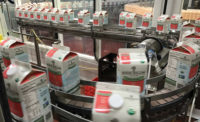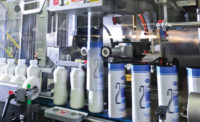
Extending Its Reach
news wire |
| Dreyer’s buys Häagen-Dazs franchise
group … Milk production rose in 2003 … Marschall show heading
back to Wisconsin … Wiscon builds new aging plant … Nebraska
dairy to supply Wells … For information on these stories and other industry news, turn to MarketWatch . |
presenting itself under various brands for various products in either the eastern half of the United States or the entire United States, depending on the
product," he says.
But the deal, which would have created the country's second-largest milk processing company, came under intense scrutiny after 10 U.S. senators asked the Department of Justice to investigate the merger amid anti-trust concerns.
ice cream, fluid milk and cultured products.
Corporate At-A-Glance |
|
Headquarters: Chelsea, Mass. Plant Locations: Agawam, Mass. (milk, cream, juice drinks); Barre, Vt. (milk, cream); Oneida, N.Y. (UHT milk, cream, beverages and mixes); Portland, Maine (milk, cream, juice); Suffield, Conn. (frozen desserts and novelties); Vernon, N.Y. (cultured); and Winchester, Va. (ESL fluid dairy). Annual Sales: About $1 billion. Top Officer: John A. Kaneb, Employees: More than 1,600. Products: A variety of branded, Customers: Market Position: No. 1 brand in History:Founded in harlestown, Mass., by Harvey Perley
Hood in 1846. Since then, the company has become one of the largest branded
dairy operators in the United States, distributing numerous brands under
license. Kaneb’s family business — The Catamount Cos., which
also owns Gulf Oil — purchased Hood |
|
Crowley Foods Acquisitions: Crowley
Foods Marigold Foods |
2 percent and 1 percent tasting like whole," she says. "It's been growing for five years and hasn't bottomed out at all. The advertising right now focuses on this 'moment of truth' where you drink a glass and it really does taste that way, kind of this pleasant surprise."
“The milk
can is a treasure trove of nutrition and flavor.” — John Kaneb, chairman, HP Hood |
specific operational duties, as opposed to gathering information from somebody and giving it to somebody else, which is, in my view, to be avoided. We are going to be challenged to maintain this management style as we grow," he says.

